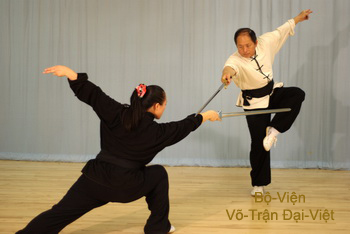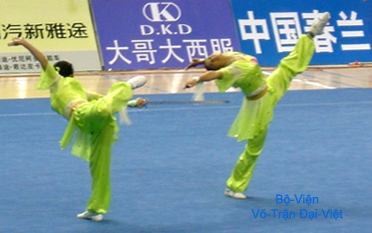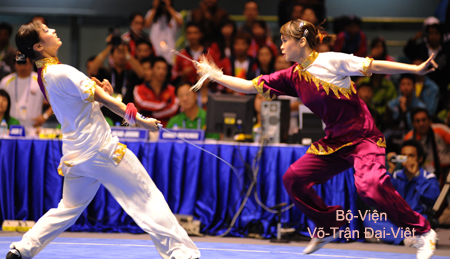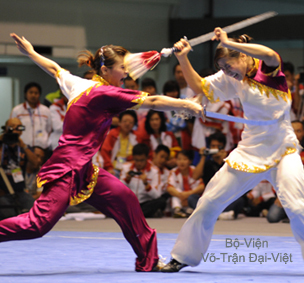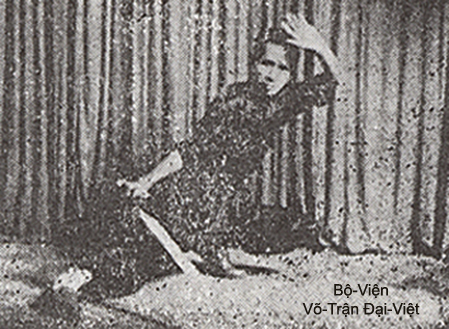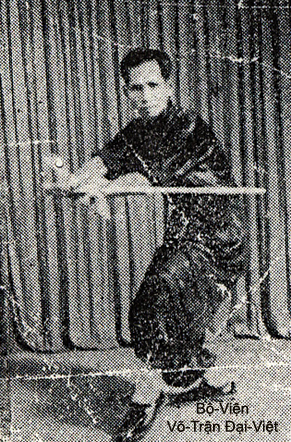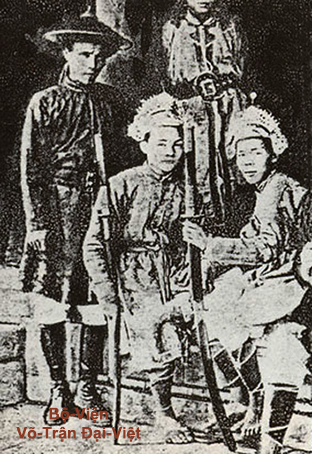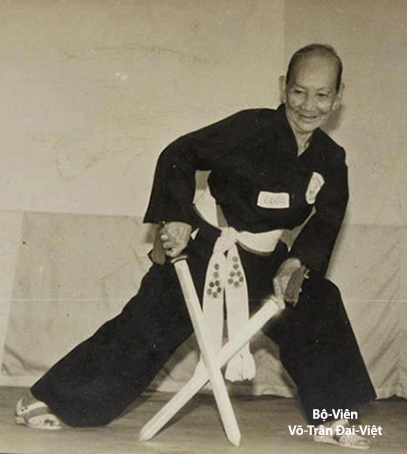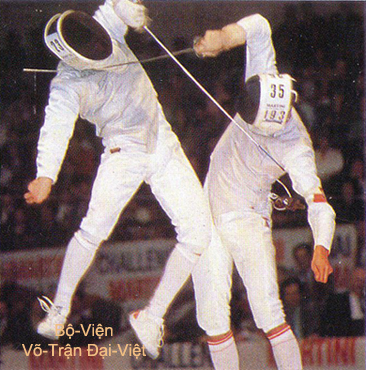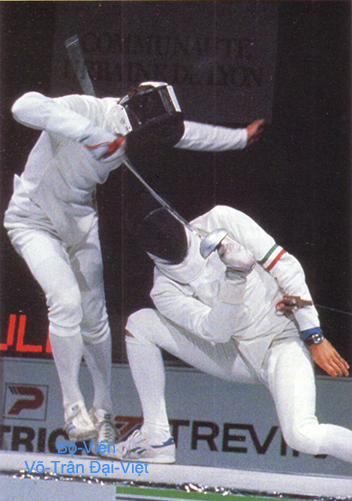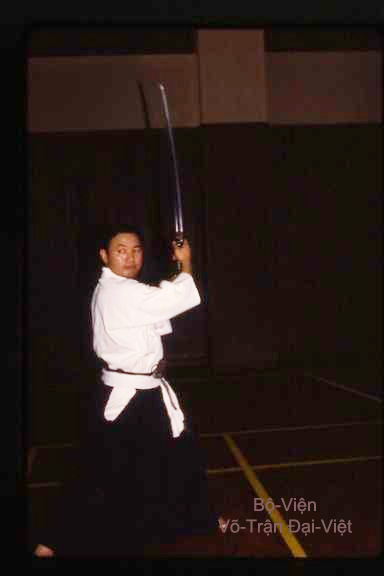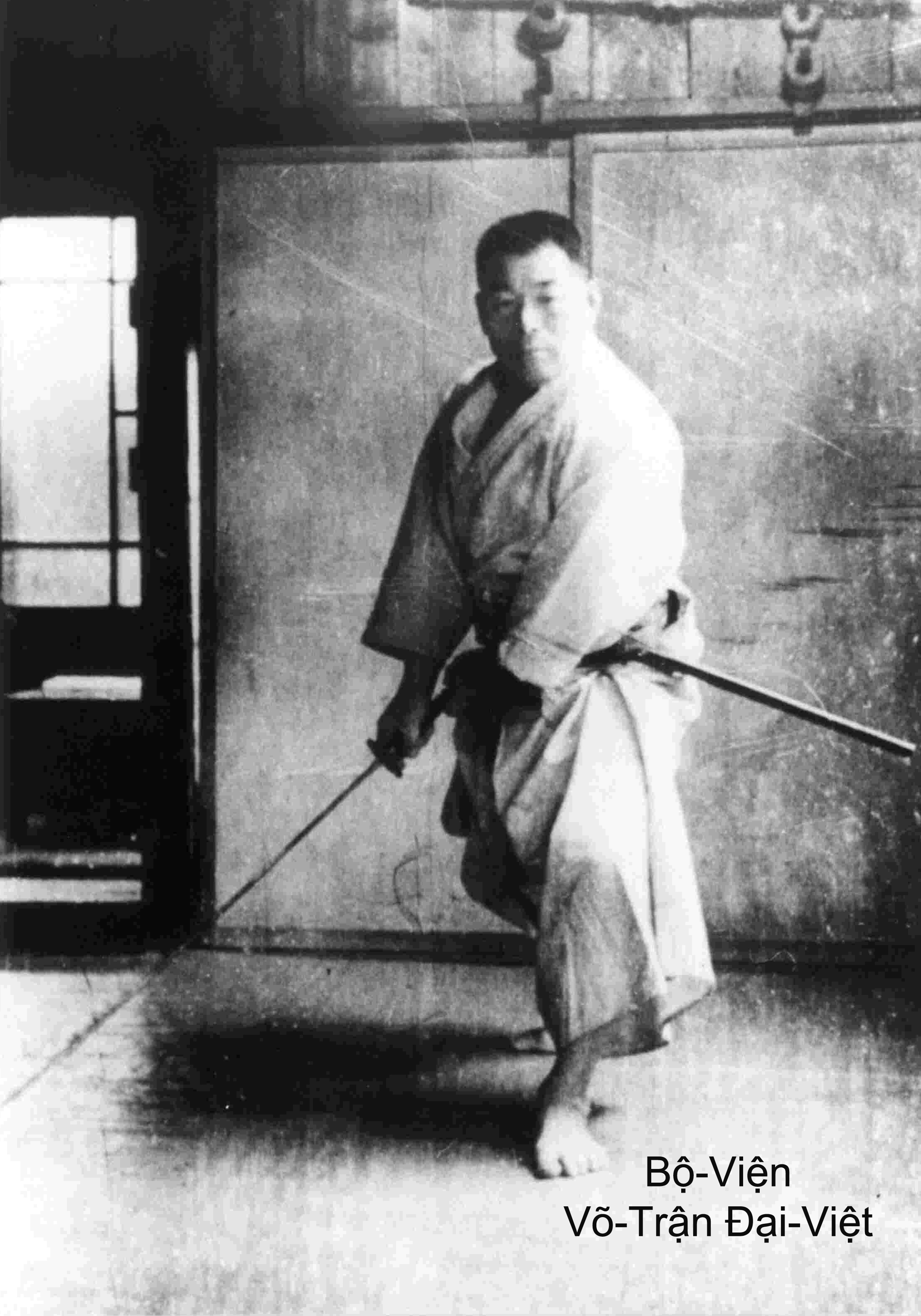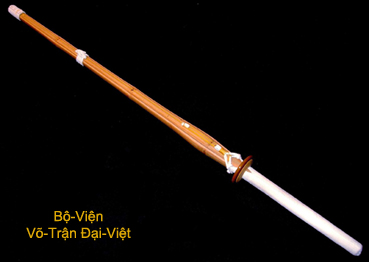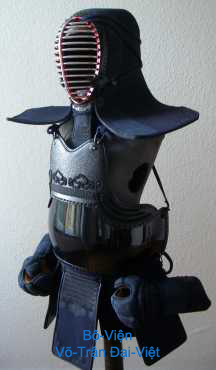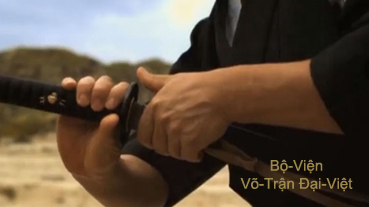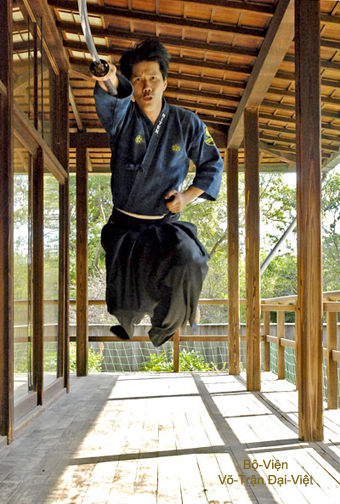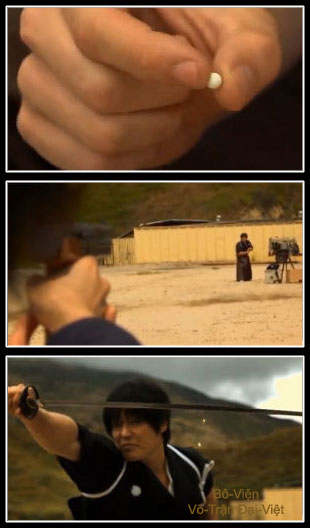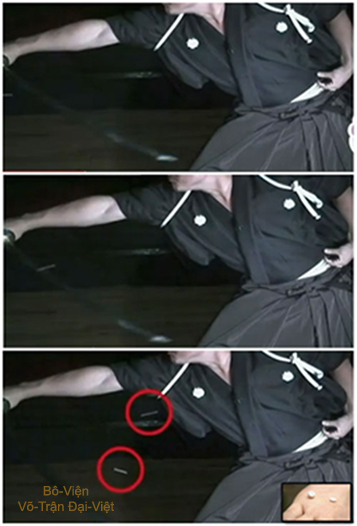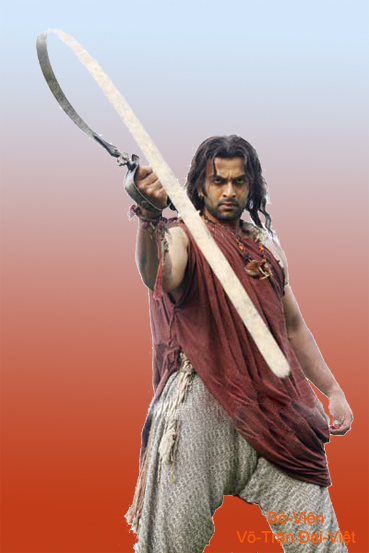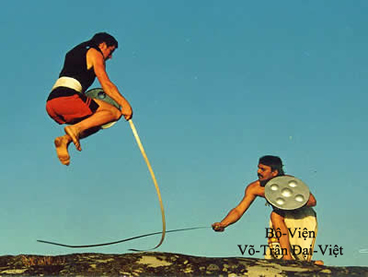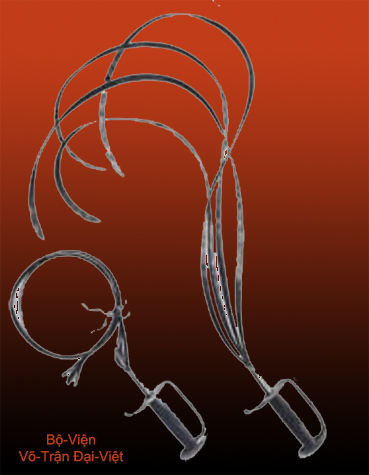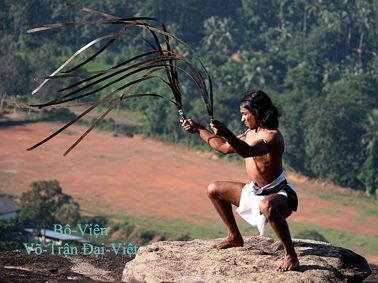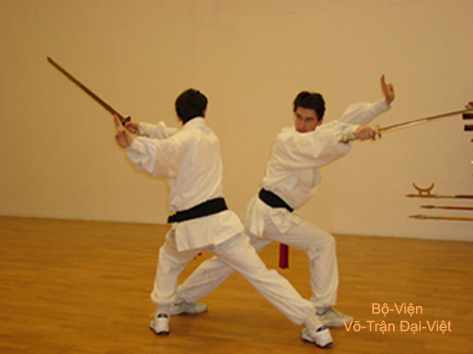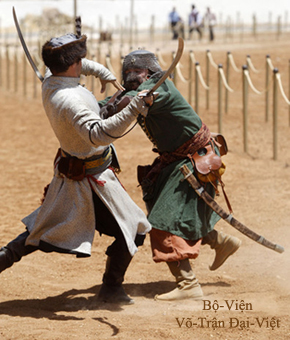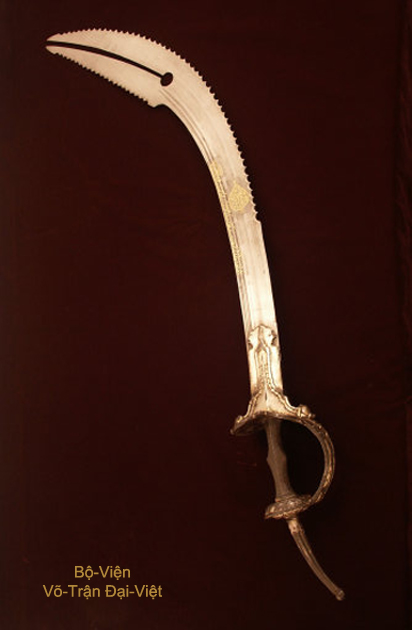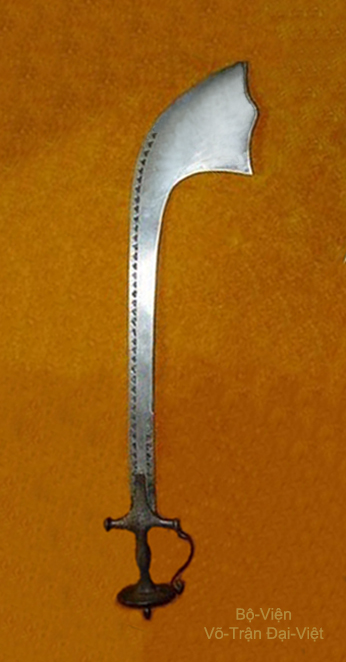II.
THE MEDIEVAL WEAPONS
2 - The Edged Arms
THE SWORD
(KIẾM)
劍
The Art of Sword
(Kiếm-Thuật)
劍術
When we discuss about the Art of Sword from Đại-Việt, naturally we must tackle the Sword WIelding Art from China because we are in the same Martial Arts Culture. But as we don't share the same Martial Arts Concept, that why the Sword Wielding Art from Việt-Nam presents numerous different points as for the Sword wielding completely different. Martial Student of Vietnamese Traditional Martial Arts must know clearly this fact.
I - The Art of Sword from Đại-Việt and from China
The application in Cof various Sword holdings - let holdings be at right way called « Chánh-Thủ-Kiếm » as Chignon-shaped Holding (Loa-Bả 螺 把), Pincer-shaped Holding (Kiềm-Bả 鉗 把), Misleaded Holding - Ðiêu-Bả 刁 把, Leaned Holding (Áp-Bả 壓 把) or those at wrong way called « Phản-Thủ-Kiếm » as To Twirl (Luân 綸), To Wrap (Vân - 耘), To Pierce (Xuyên 穿), To Carve (Quái 劊), To Sweep (Tảo 掃) - is totally different from the one in Chinese Fencing.
A - The Chinese Fencing go by the clear distinction between the both fields « Waiting Sword - Trạm-Kiếm - 站 劍 » and « Nonstop Sword - Hành-Kiếm - 行 劍 » ; that why it owns until 24 ways of Sword wielding :
01. Tiễn (筅) : To Shoot (Arrow), 02. Thích (刺) : To Thrust, 03. Phách (劈) : To Split open, 04. Khảm (砍) : To Cut, 05. Liêu (撩) : To Sever upward, 06. Đào (逃) : To Hind, 07. Phao (拋) : To Push back, 08. Lan (攔) : To Block, 09. Bằng (憑) : To Press, 10. Quái (劊) : To Carve, 11. Mạc (漠) : To Slash, 12. Thác (錯) : To File down, |
13. Cổn (滾) : To Plunge, 14. Điểm (點) : To Point, 15. Vân (雲) : To Wrap (Cloud), 16. Điền (填) : To Fill, 17. Xung (衝) : To Attack, 18. Giảo (絞) : To Grip, 19. Thúc (束) : To Tie up, 20. Thác (托) : To Lift, 21. Đề (提) : To Raise, 22. Điêu (刁) : To Mislead, 23. Liệt (裂) : To Tear up, 24. Loát (捋) : To Smooth. |
With the 24 ways of Sword wielding above, Chinese Fencing had a very high level and truthly rich in the pass.
The sublimity of Chinese Fencing Art from bygonedays was having led Escrimeurs to own the Suprem Notion in the Metaphysical Philosophy concerning the Art of Sword from Transcendant Beings (劍 仙 Kiếm-Tiên). That's « Kiếm-Khí 劍 氣 - Sword becoming Vital Breath Khí », « Kiếm-Quang 劍 光 - Sword becoming Light », « Kiếm-Nhãn 劍 眼 - Sword becoming Look »...
Quant à la richesse de l'Art de l'Epée de la Chine, elle fut due jadis au fait que toutes les Ecoles d'Escrime possédèrent la capacité de concevoir respectivement une Epée forgée pour l'Art de l'Epée spécifique de chacune de leur Ecole : les Epées des Ecoles réputées comme « l'Ecole d'Escrime Toàn-Chân 全 眞 », « l'Ecole d'Escrime Hoa-Sơn 花 山 », « l'Ecole d'Escrime Nga-Mi 峨 嵋 », « l'Ecole d'Escrime Không-Đông 崆 峒 », etc., furent toutes totalement différentes les unes des autres. Il suffit de les voir pour en distinguer le nom déclaré de chaque Ecole.
In nowadays, with the development of China Wu-Shu Sportive Martial Arts, the most of commercial markets reserve in priority whole equipment for them, to find on these markets a precious Sword, forged in Welded Steel, allowing then to use efficiently the 24 ways of Sword wielding quoted above, isn't an easy thing.
Fencing Master Yang Jwing Ming
was demonstrating
|
Chinese Fencing Students was presenting
|
Vietnamese Fencing Students Trà-My and Thùy-Linh was presenting the modern Chinese Wushu Art of Sword at Sea Games 25th .
|
Vietnamese Fencing Students Trà-My and Thùy-Linh
|
B - As for Đại-Việt Fencing, like Traditional Martial Arts of Bình-Định moreover, it's based on the « Elimination of Proxility principle in the name of Expurgation » (khứ vu tồn thanh) and on the « Deletion of the Complication principle in the name of Realization of SImplicity » (San Phồn Tựu Giản).
It was forged by the Ancients on battle fields, in order for fighting the numerical superiority, acccording to the Martial Principle of « to use that is short for defeating that is long - to use that is is Soft for dominating that is Hard ».
Therefore, the Traditional Fencing from Bình-Định (Việt-Nam) calls for only 12 ways of Sword wielding :
| 01. To Thrust - Đâm - (Thích 刺) 02. To Cut - Chém - (Khảm 砍), 03. To Slash - Vót - (Mạc 莫), 04. To Peel - Gọt - Tước (削), (𠞡) 05. To File down - Giủa - (Thác 錯), 06. To Smooth - Vuốt - (Loát 捋). 07. To Escape - Thoát - (Thoát 脫), 08. To Raise - Nâng - (Đề提), 09. To Press - Đè - (Bằng 憑), 10. To Wrap - Bọc - (Bao 包), 11. To Overturn - Lật - (Đảo 倒), 12. To Drown - Dìm - (Trầm 湛). |
With these 12 ways of Sword wielding quoted previously as well as their spécific application's way from Battlefields Martial Arts of Vietnameses, with a view to Defeating the Speed by the Slowness according to the Martial Principle of « to control the Disturbance by means of the Serenity », thus the Art of Sword from Đại-Việt cristallizes « Waiting Sword - Trạm-Kiếm - 站 劍 » and « Nonstop Sword - Hành-Kiếm - 行 劍 » in only one Art of Sword, that's the « Sword in Action - Tác-Dụng Kiếm - 作 用 劍 ».
We only have to compare Codified Sequences in Đại-Việt Fencing as « Trường-Kiếm » (長 劍), « Long-Môn-Kiếm » (龍 門 劍), « Độc-Long-Kiếm » (獨 龍 劍), or « Long-Vân Kiếm » (龍 雲 劍) with those in Chinese Fencing as « Đạt-Ma Kiếm » (达摩 劍), « Thái-Cực-Kiếm » (大 極 劍), « Ngũ-Hành-Kiếm » (五 行 劍), or « Long-Hành Kiếm » (龍 行 劍) to be clear in one's mind about it.
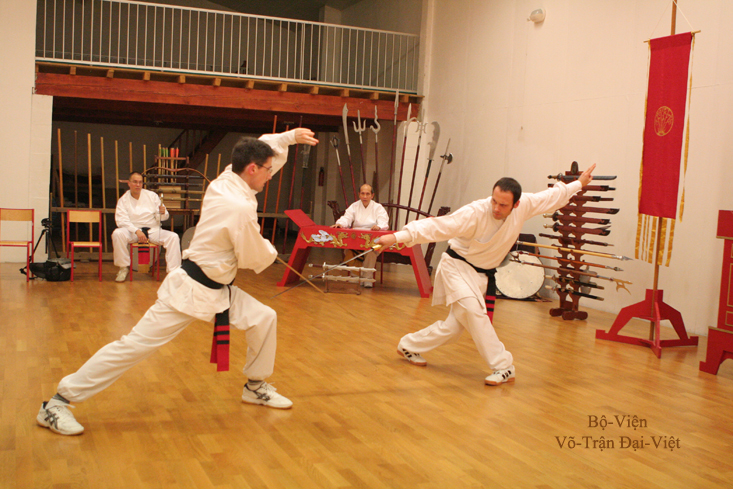
Martial Students from Bình-Định Sa-Long-Cương School System was training for duel with Fencing Art
in the Tradition of Battlefields Martial Arts.
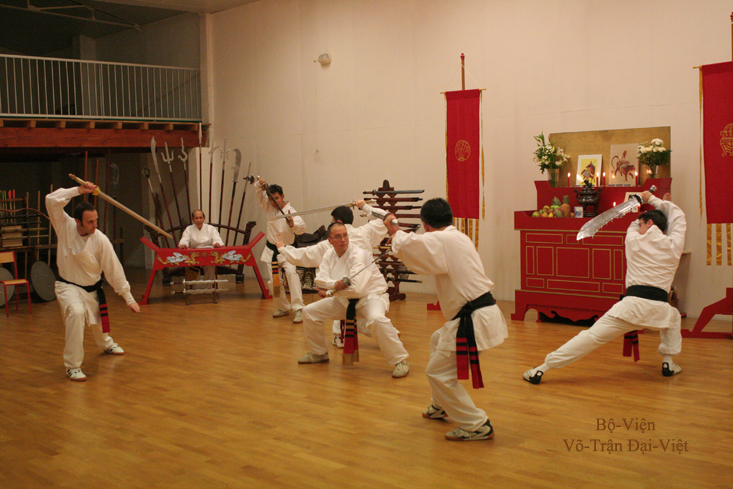
Martial Students from Bình-Định Sa-Long-Cương School System was training for the collective combat
with edged arms
in the Tradition of Battlefields Martial Arts.
Throughout so much of vicissitudes of History, the Sword Art Wielding from Việt-Nam becomes a discipline too few interested by people.
At the time of the Resistance War againts Frenchies, in Bình-Định, the Old Grand-Master PHẠM-Hiếu father of our Grand-Master PHẠM-Thi, had forged 12 techniques of Martial Arts Lineage from Commander PHẠM-Tường for teaching to North-Vietnameses Armies and that the last one having still learned was the late Master Hà-Trọng-Sơn. However this Master didn't specialize in the Sword Art Wielding but in the Kick Boxing on Ring.
At the time of Việt-US War, the country was divided into two nations, in South Việt-Nam there were only 3 Old Masters who realy handed down the Art of Fencing. That were :
1 - Old Master Phi-Sơn-Hải (vô-địch Kiếm-Thuật Việt-Nam at Hà-Nội
on 1937), who teached the Sword Art Wielding in his Drill Hall at Yên-Đỗ Street. He was the unique man having proposed to President Ngô-Đình-Diệm and having formuled the request to teach the Sword Art to South-Vietnam armies in order to thwart the scimitar wielding of North-Vietnam combatants, but his suggestion was refused ;
2 - Old Master Lê Văn Kiển (alias Tám Kiển) who teached the Sword Art Wielding at the Sports Club Sân Vận-Động at the Phan-Đình-Phùng street ;
3 - Old Master Trương-Thanh-Đăng (founder of Sa-Long-Cương Martial Arts System School) who teached the Sword Art Wielding in his Drill Hall at Nguyễn-Cư-Trinh street.
Fencing Master Phi-Sơn-Hải |
Fencing Master Phi-Sơn-Hải with his renamed Guard. |
In nowadays, the Việt-Nam is unified, Vietnamese Traditionnels Martial Arts disciplines in general and these of Bình-Định Traditional Martial Arts in particuliar, with the development according to the sportive steps of Wu-Shu in China, are well known at present by the world. A fact which deserves to dread is that since then, Vietnamese Martial Students have tendance to imitate the movements of Codified Sequences presentation in the style of Wu-Shu Martial Students of China. This fact drives us to ask ourselves in silence many questions on the Art of Sword from Đại-Việt that our Ancestors have so struggled to hand down them to us. Above all, when we see that the Sword wielding Codified Sequence from Đại-Việt, including Seven to the power Three = 343 Fencing Lunges in the School System Sa-Long-Cương, isn't teached currently in Việt-Nam, because it has been replaced by the Codified Sequence « Đạt-Ma Kiếm » (达摩劍) from China. All as we see that the Codified Sequence of « Độc-Long Kiếm » from Đại-Việt has been altered into the one of «Thanh-Long Độc-Kiếm», thus plagiarizing the chinese Sword wielding...
Swordmen of the Imperial Guard
well accustomed (Credit Photo : Nguyễn Khắc Ngữ)
|
Grand Lady Phạm-Cô-Gia from Traditional Martial Arts (Credit Photo : School System Phạm Cô Gia) |
These divergent aspects, between the Fencing Art from Đại-Việt and the one of China, have been founded by the war and for the war. If Martial Arts of Vietnamese Ancestors imitated by plagiarizing those of China, then how could them be able to fighting their invaders armies numerically well superior, in the times when Martial Arts were esential ?
Beyond of what is quoted above, the Art of Sword from Đại-Việt and the one from China own in spite of all, common points in the Litterary Culture in general and in Martial Culture in particuliar. And it exists two main points in the Art of Sword whom Codified Sequences from these two countries are the well obvious proof. Since the old times, Đại-Việt and China have always :
1) - considered the Dragon as a Symbol for the Sword Edged Blade ;
2) - conserved the « Sword Thrust and the Sword Cut » in the respective sword wielding.
That's neither the case of the Fencing Art in Occident who has abandoned completly the « Sword Cut » in favor of the « Sword Thrust », nor the case of Japan who, in contrario, gives priority to the « Sword Cut » (Suburi) to the detriment of the « Sword Thrust » (Tsuki).
So, we arrive the point where we need to talk about the Fencing Art from Italia and France in Occident and the one from Japan in Orient.
II - The Art of Sword from Italia and France
The Fencing Art from Italia and France in Occident, after having been developped untill supreme level, it became an International Sport very inside the Olympic Games.
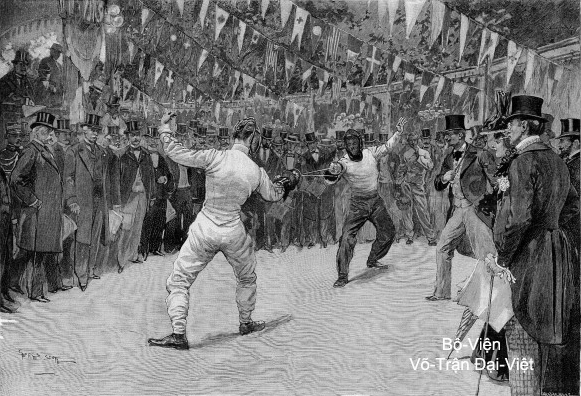
The International Tournament of Fencing - A Seance at Paris Garden - Illustration from June 13th 1896.
Painting from Georges Scott, 1896.
With Eight Ways to hold the Sword according to the anatomy of the wrist : « Prime, Seconde, Tierce, Quarte, Quinte, Sixte, Septime, and Octave », Italians and Frenchmen in Europe have perfected their Medieval Fencing into a very high level in 17th centurie throughout the using of a kind of Sword called « Rapière ».
Later, the Fencing Art of Europe didn't cease to perfect oneself, and a category of new Sword was invented under the name of « Fleuret », shorter and lighter than the « Rapière », in order to training for and making research on the Xiphonomy or Fencing Art.
Then about from the late 18th centurie to the early 19th centurie, the European Fencing Art reached a supreme level never still reached. that's there the period where appeared renamed Fencing Masters among whom we must quote :
- Italian Masters Parise Masaniello - (1850 -1910), considered the "father of Italian fencing.", Nadi Aldo - (1899 - 1965) who was the undefeated European champion for 12 years in a row, one of the greatest Swordsman of all times, Santelli Italo – (1871 – 1945) considered one of the greatest of modern Fencing Masters ;
- and French Fencing Masters as Louis Justin Lafaugère (1782-1856), the talentuous Master of the Royal Guard's Hussards, Jean Louis Michel (1785-1865), the invincible Master in Europe, settled in Montpellier, where he founded what became the most famous Fencing School, and A.J.J. Posselier, celebrious under the name of "Gomard", the renamed Master of the King's Grey Mousquetaires.
Among these Three French Fencing Masters, it's truthly regrettable that Master Jean Louis Michel (1785-1865) didn't write a book on the Sword wielding in order to make know to the world about his exceptional Fencing Lunges, but only the Master Lafaugère has written a Treatise on Fencing (1825) for explaining and teaching the 12,500 Coups & Bottes from his School and the Master Gomard has written a Book on Fencing Theory (1845) for handing down to the posterity the 336 Coups & Bottes from his School, carefully studied, analyzed and defined.
Italians and Frenchmen in Europe, after having developped their Fencing art untill suprem level, have transformed it to an International Sport in Olympic Games, and since then, their Fencing Art full of virtuosity and subtleties, was became a kind of Fencing which doesn't still deserve his name declaimed.
When the Fencing Art with Sword Thrust training for at |
When the Fencing Art with Thrust Sword training for at |
III - The Art of Sword from Japan
The Japanese Fencing Art associeted to the so edged Sabre-Gươm called « Katana », originating from marvellous smithing technology of welded steel swords from the TANG Dynasty (618~907 AD) period, is nowadays renamed in all five continents and four oceans. That's here a cultural phenomenon and not a sportive fact like the Occidental Fencing is.
Throughout the Three particular Movements concerning : 1. Nukitsuke (Bạt-Kiếm 拔 劍 - To Draw the Sword), 2. Chuburi ( 血振 Huyết-Chấn - To Shake for taking the Blood away the Sword) and 3. Noto ( 納刀 Nạp-Đao - To Sheathe the Sword), The Japanese Fencing has intensified the epic, dynamic and esthetic lines of the precious Sword that the Ancients has beaquated the Art of forging it.
And throughout the Movements Kamae with Five kinds of fondamental Guards (1. Seigan, 2. Hasso, 3. Jodan, 4. Gedan, 5. Waki) and the Movements Kiritsuke with Seven Lunges of Cut (1. Shomen Uchi, 2. Migi Kesagiri, 3. Jidari Kesa Giri, 4. Migi Yoko-Guruma, 5. Hidari Yoko-Guruma, 6. Migi Gyaku Kesagiri, 7. Kidai Gyaku kesagiri) and One Lunge of Thrust (Tsuki) the Japanese Fencing has offered to the world a source of concise pedagogy from the ancient Far-East Culture which has been already conserved, as it has divulged to the world the precious Esotéric Formula from the Far-East « The Vital Breath, the Sword and the Body Unified in the same One Spirit » (Kikentai no ichi 気剣体の一) as well as it has raised the Sword wielding to the rank of a Spiritual Way.
Kenjutsu Master Ohno in Guard (Credit Photo : Tetsudokan Jujitsu - Willoughby, Ohio) |
Kenjutsu Master Kunii Zen'ya
in specifical Guard |
Effectively, in the early 17th century, the Master Naganuma Shiro invented the Bamboo Sword "Shinai " and the Training Armour "Bogu " so that Fencing Students can to train for in whole security, instead of to use Wooden Swords "Bokken" and Steel Sword Katana". This equipment has aided Fencing Students to pass from Fencing's Study with the Killing Sabre (Setsuninto 殺人刀) into the Fencing's Study with Alive Man Sword (katsuninken 活人劍 剣).
The Bamboo Sword « Shinai » |
The Training Armour « Bogu » |
Then in 1912, the Japan has raised his Art of the Sword (劍 術 Kenjutsu Kiếm-Thuật) to the rank of a Spiritual Way and officially changed it in Way of the Sword (劍 術 Kendo Kiếm-Đạo) with the divulgation of Codified Sequences "Katas" for the Kendo (Nihon Kendo no Kata).
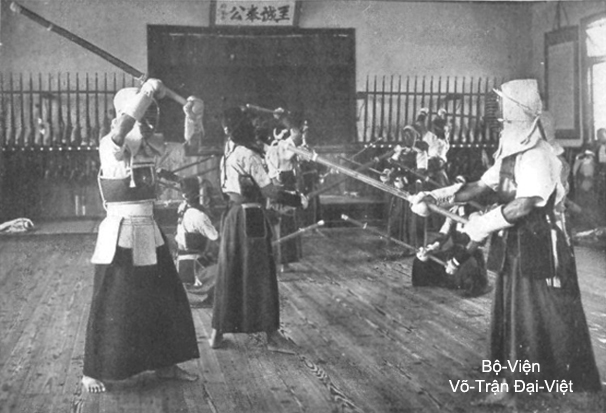
A Drill Hall training for Kendo (Kiếm-Đạo)
in an Agriculture's School in Japon circa 1920.
(
The Kendoka on the left was in Guard « Jōdan no Kamae »
and the Kendoka on the right in Guard « Seigan no Kamae »)
The International Federation of Kendo (FIK), whom the head office is in Tokyo at the Japanese Federation ZNKR (Zen-Nihon-Kendo-Renmei or All-Japan-Kendo-Federation), has been created in 1970 by 17 countries and founders federations. In 2006, the FIK counted 47 members. It has for goal the international development of the kendo and associated disciplines « Iaidō » (居合道 Cư-Hiệp Đạo) and « Jōdō » (杖道 Trượng Đạo).
- The Jōdō (杖道 Trượng-Đạo) rises in Jō-Jutsu (杖術 Trượng-Thuật) from Shindo Muso (Shindo Muso Ryu) Martial Arts Trend, founded by the celebrious Master Musō Gonnosuke in the year of 1605. That was precisely the Master T. Shimizu who had raised the Jō-Jutsu (杖術 Trượng-Thuật) to Jō-Đō (杖道 Trượng-Đạo) only just afterwards the du Pacifque War during the 2nd World War and in the first place for teaching the Police.
- The Iai-Do (居合道 Cư-Hiệp-Đạo) rises in Battō-Jutsu (抜刀術 Bạt-Đao-Thuật), still called more literary by Iai-Jutsu 居合術 Cư-Hiệp-Thuật, founded by the celebrious Master Hayashizaki Shinsuke Shigenobu, born in the year of 1542 at Shinzaki in the Dewa. That's the method of Drawing and Striking a Sword Cut in the same one movement under any direcction.
The Swordman Machii Isao was preparing to to draw |
The Fencing Master Jorge Kishikikawa in a Drawing and Jumping Technique while he was striking a Sword Cut |
The successful development of this discipline Iai-Dō (居合道 Cư-Hiệp-Đạo) is due to two reasons :
1 - The first reason is the sudden awareness of Fencing Masters from Meiji (Minh-Trị) era that if they didn't grant to divulge this discipline Iaido to the multitude, it would be doomed to the disappearance ;
2 - The second reason is the will of Fencing Masters having founded the modern Kendo to want not to leave the Kendo to distort in a Sport.
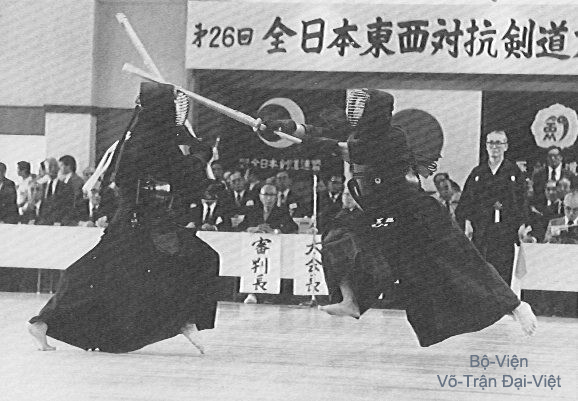
When the Fencing Art with Sword Cut training for at
the virtuosity and full of subtleties
having been transformed
to become
a Sport of Competition..
And this Battō-Jutsu (抜刀術 Bạt-Đao-Thuật) - still called Battō-Do (抜刀道 Bạt-Đao-Đạo) - from Japan could forge so much Swordmen achieving the precious Esoteric Formula of the Fencing Art : « Vital Breath, Sword and Body Unified in the same One Spirit » (Kikentai no ichi 気剣体の一) whom among them exists in nowadays, in the year of 2012, an amazing Swordman named Machii Isao :
The Swordman Machii Isao was drawing his Katana (Credit Photo : http://www.le-saviez-vous.fr) |
The Swordman Machii Isao was drawing his Katana (Credit Photo : http://www.le-saviez-vous.fr)
|
IV - The Fencing Art and the Sword Blade
To conclude, we can affirm the intimate relation and the obvious correspondence between the Fencing Art and the Sword Blade.
Effectively, in general, the Morphology of the Sword Blade expresses the Fencing Art concerning it :
- In the Straight Blade wielding, the lunges of Thrust are easier than the Lunges of Cut ;
- In the Curve Blade wielding, the lunges of Cut are easier than the lunges of Thrust.
However, the Morphology of the Sword Blade in the world is very varied, by consequent it induces very numerous different Fencing Arts, according to each nation's regions.
A) - As regards the Straight Blades, grosso-modo it exists Two Great Categories of Swords :
1 - The Great Category of Stiff Swords ;
2 -The Great Category of Flexible Swords.
A1 -The Great Category of Stiff Swords includes Three Classes of Swords :
a) - The Class of Stiff Swords with Unique Straight Blade holding Two Smooth Edges : That's the category of renamed Sword since Mérovingiens Dynasty (500~751 CL) period in France and from Springs-Autumns period « Xuân-Thu Thời-Đại - 春 秋 時 代» (722-481 BC) in China ; That's also the category of Sword the most employed in the world.

Stiff Sword with Two-Edged Straight Blade from Câu-Tiễn (Goujian) King of Việt (Yue)
since the Springs-Autumns period (722-481 av.JC)

Stiff Sword with Two-Edged Straight Blade from MEROVINGIENS Dynasty (500~751 JC) period.
(Historic Re-Enactment by Gaël Fabre)
b) - The Class of Stiff Swords with Unique Straight Blade holding One Edge : That's the category of renamed Sword from TÙY (SUY 581~618 BC) Dynasty period and from ĐƯỜNG (TANG 618~907 BC) Dynasty period and of ancient Sword specific to Đại-Việt ;

Stiff Sword with Unique Straight Blade holding One Edge
from ĐƯỜNG (TANG) Dynasty period ( 618-907 AD) .

Stiff Sword with Unique Edge Straight Blade and with Raised Point
from ĐẠI-VIỆT
(circa 15th ~19th centuries).
(Historic Re-Enactment by Michel Souquet)
c) -The Class of Stiff Swords with Unique Straight Blade holding Edges with Particular Sawed Shape Teeth : that are Swords belonging to the Category of « Blades-Breaker Swords Kiếm-Giản ». This Class of Swords is divided into Two distinct Groups :
α)) The Group of Stiff Swords with a Straight Blade holding Asymetrical Edges (with One Sawed Shape Teeth Edge) :
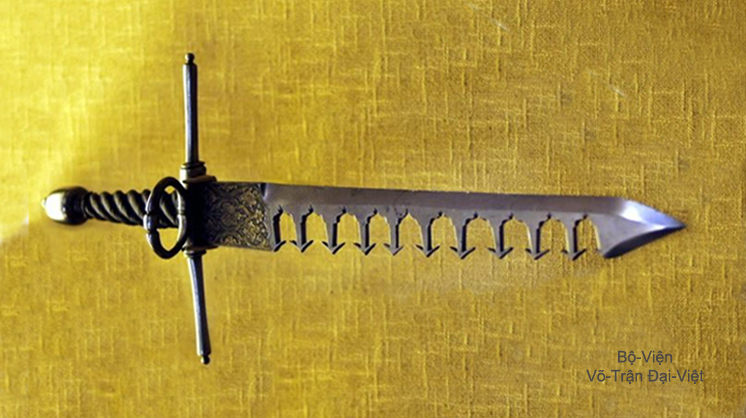
One-Handed « Blades-Breaker Dague-Sword »
holding a Straight Double Edged Blade with Particular Sawed Shape Teeth.
ITALIA - Late 16th Century
β) The Group Stiff Swords with a Straight Blade holding Symetrical Edges (with Two Sawed Shape Teeth Edges) :
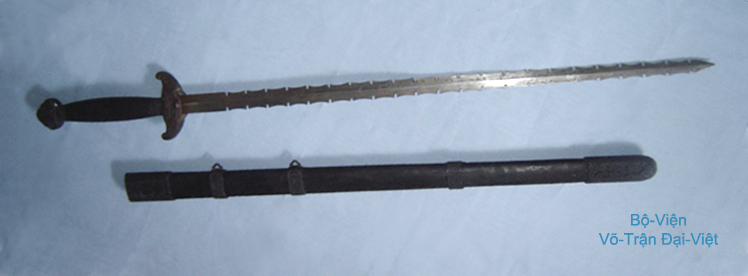
One-Handed « Blades-Breaker Sword »
holding a Straight Double Edged Blade with Particular Sawed Shape Teeth.
CHINA - 19th Century
A2 - The Category of Flexible Swords with Straight Blade holding Two Edges - It's called in Sino-Vietnamese by Nhuyễn-Tiên-Kiếm 軟 鞭 劍, in Hindi by Urumi, and it's divided into Two kinds :
a) - Flexible Swords with Unique Straight Blade holding Two Edges : that's the Flexible Sword Nhuyễn-Tiên-Kiếm 軟 鞭 劍, specific to three countries : « China » (traditionally with neither guard nor under-guard), « India » and « Malaysia » (with guard and under-guard protecting the hand) ;
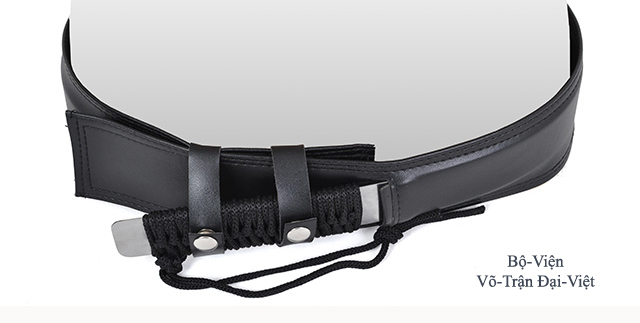
China Flexible Belt-Sword - Nhuyễn Tiên Kiếm 軟 鞭 劍
with Unique Straight Blade
holding Two Edges
(Re-Enactment by ChinaTown-Shop)
Fencing with Flexible Sword « Urumi » |
b) - Flexible Swords with Multiple Straight Blades (having from 4 into 6 Flexible Blades) holding Two Edges : That's the Flexible Sword with Straight Blade specific to India and held in high esteem in Malaysia :
- at North-Kerala it's called « Urumi » and still called inTamil
by Surul Pattai ;
- at South-Kerala according to the Malayalam language by « Chuttu-Val »i.e. Coiling Sword (Quyển-Kiếm 捲 劍 ). Tha's the weapon often employed according to the Two Matched Flexible Swords, specially used to break encircling manœuvres of many opponents and whom wielding technique is very arduous and above all dangerous for the very user.
B) - As regards the Curved Blades, still called Sabre-Gươm, grosso-modo it exists 2 categories of Swords, divided according to the Curve of the Blade into :
B1 - Sword with Curved Blade from the middle of the Blade into the Point ; it's there the Sword with Curved Blade of great majority in the world. However, it exists within this very Sword Category with Curved Blade Two kinds of Sword :
a) - Sword witk Curved Bkade holding a Smooth Edge :

« One-Handed Sabre-Gươm » of ĐẠI-VIỆT
with an Inferior Edge (Hạ-nhận 下 刃) and a short Superior Edge (Thượng-Nhận 上 刃) or "Contre-Tranchant",
located near by the point of the Sword, on the side of the back blade.
Đại-Việt - Circa 18th~19th centuries
b) - Sword witk Curved Bkade holding a Saw-Shaped Blade :
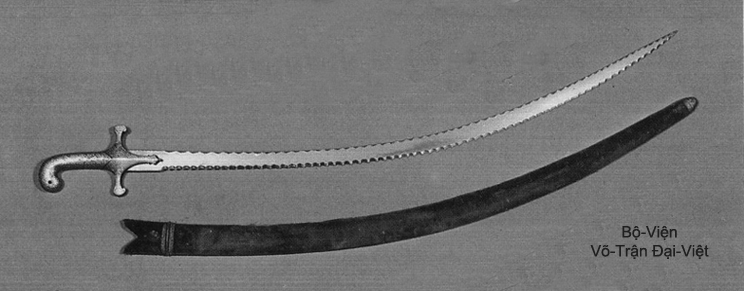
One-Handed Sword « Shamshir »
with a Saw Shaped Blade.
India - 18th Century
B2 - Sword with Curved Blade from the middle of the Blade into the Guard ; it's there the Sword with Curved Blade (called Katana) specific to Japan.
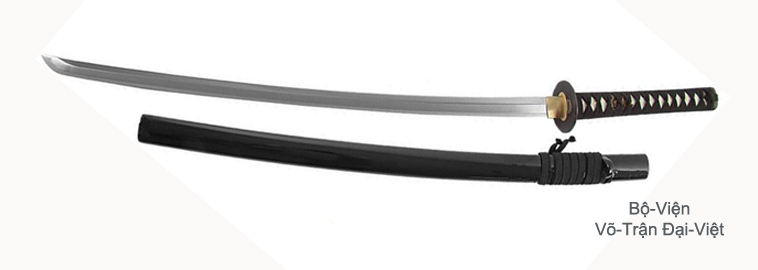
The renamed Sabre-Gươm « Katana » from Japan,
with Curved Blade from the middle
of the Blade into the Guard.
(Photo Credit : Paul CHEN)
C) - As regards the Wavy Blade Sword, groso-modo it includes Two categories of Sword :
:
C1 - The Wavy Blade Sword invented in West. Tha's the one's invented in France and includes Two different kinds :
a) The Two Handed Wavy Blade Sword generally called « Flamberge » (becoming from the Name of the Renaud de Montauban's Sword - a 9th Century Knight, in the reign of Charlemagne ) ;
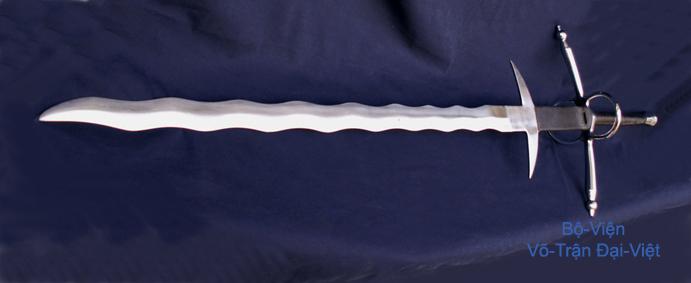
French « Flamberge », a Two-Handed Sword
with Wavy Flamed Shape Blade.
(Historic Re-Enactment)
b) The One Handed Wavy Blade Sword belonging to the transformation of the Sword called « Rapière ».
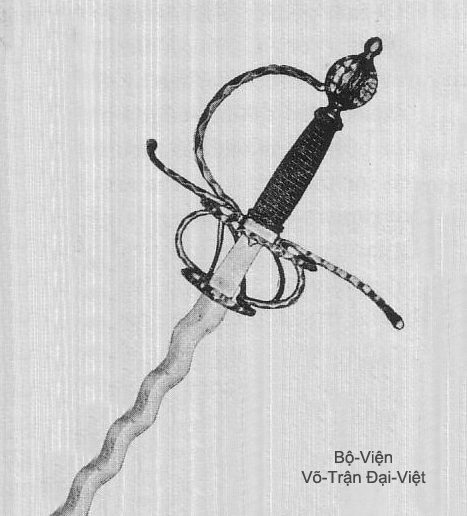
French « Rapière », an One-Handed Sword
with Wavy Flamed Shape Blade.
FRANCE - Late 16th Century
(Photo Credit : George Cameron Stone)
C2 - The Wavy Blade Sword invented in East. Tha's the one's including Six different Classes α, β, γ, δ, ε and ζ, divided into Two distinct Groups :
C2a - Group of Swords holding a Wavy Asymetrical Blade dividing oneself into Three Classes :
α - The Class of Handed Wavy Blade Sword created in India from the Sabre « Shamshir » and the Sabre « Khanda » :
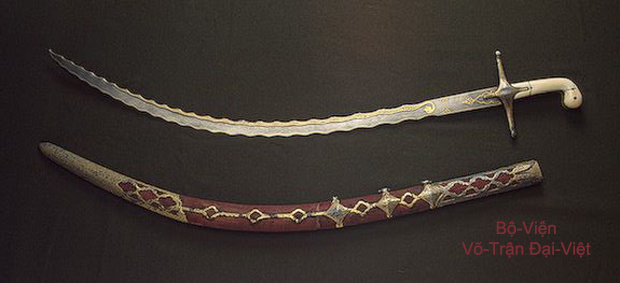
Arabian One-Handed Sabre « Shamshir »
with Wavy Blade.
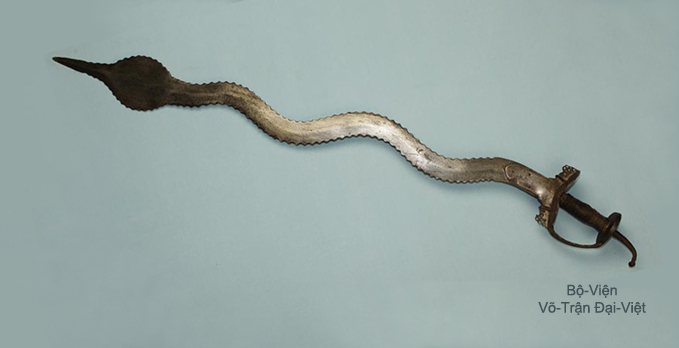
Indian One-Handed Sabre « Khanda »
with Wavy Snaked Shape Blade,
ending in Cobra Head towards the Point.
β - The Class of Handed Wavy Blade Sword created in Malaysia & Indonesia & Philippines under the name of « Keris or Kris » ;
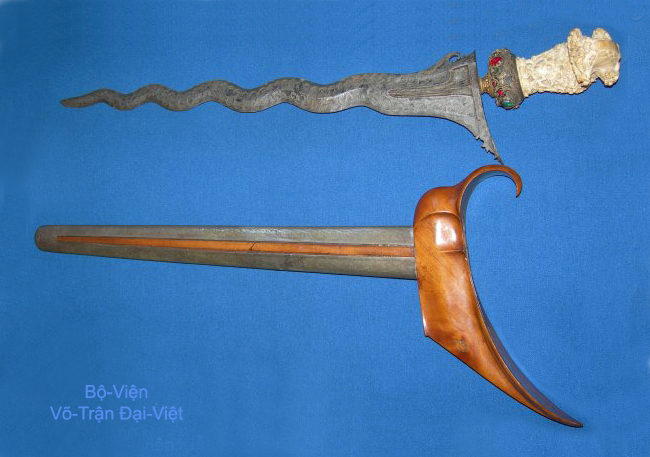
Indonesian « Keris or Kris », an One-Handed Sword
with Wavy Snaked Shape Blade.
γ - The Class of Handed Wavy Blade Sword created in China under the name of « She Jian 蛇 劍 Xà- Kiếm - Sword with Snaked Shape Blade ».

Chinese « She Jian 蛇 劍 Xà Kiếm », an One-Handed Sword
with Wavy Snaked Shape Blade.
C2b - The Group of Swords holding a Symetrical Wavy Blade ; that are
Edged Arms rangées in the Category of Rigid War Flails - Ngạnh-Tiên, dividing oneself into Two Classes :
δ -The Class of One-Handed Unique Rigid War Flails and Two Matched Rigid War Flails ;
ε -The Class of Two-Handed Unique Rigid War Flails.

« Single Rigid War Flail » from Đại-Việt
« Độc-Ngạnh-Tiên »
( 獨 硬 鞭 )
Two-Handed Sword holding a Symetrical Wavy Blade of Đại-Việt
(Historic Re-Enactment by Võ-Trận Đại-Việt Department)
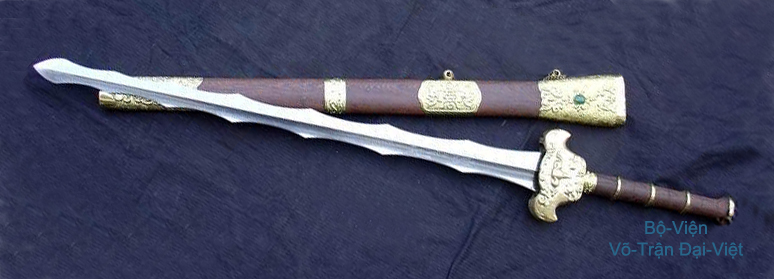
« Single Rigid War Flail » from China
« Độc-Ngạnh-Tiên »
( 獨 硬 鞭 )
Two-Handed Sword holding a Symetrical Wavy Blade of China
(Reconstruction for Training in Martial Arts Drill Halls)
Thus, it is perfectly understandable that it exists in the Edged Weapons category so much kinds of Swords as that it exists in Fencing Arts so much Sword Wielding Arts. And each Fencing Art requests the possession of a Sword capable to aid effectively his Wielding Art.
Fencing with « Indian Sabre Talwar » in Jordan. (Credit Photo : Al Faris International |
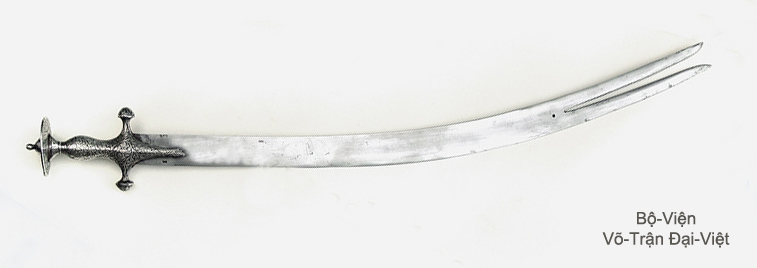
Indian & Persian Art Replica of the legendary invincible Sabre-Gươm « Zulfiqar - Dhû'l-fiqâr »
of Muslim Generalissimo Ali ibn Abi Talib (600 ~ 661 AD).
Turkish & Persian Art Replica of the legendary invincible (Credit Photo : http://theblogthattimeforgot.blogspot.fr) |
The Sabre-Gươm « Kora » (Credit Photo : http://theblogthattimeforgot.blogspot.fr) |
Committee of TRỊNH Quang Thắng. |
-
Discussion about the Sword
-
Discussion about the Fencing Art
-
Discussion about the Unique Sword Wielding
Copyright © 2004 - 2019 by ACFDV - All rights reserved.
